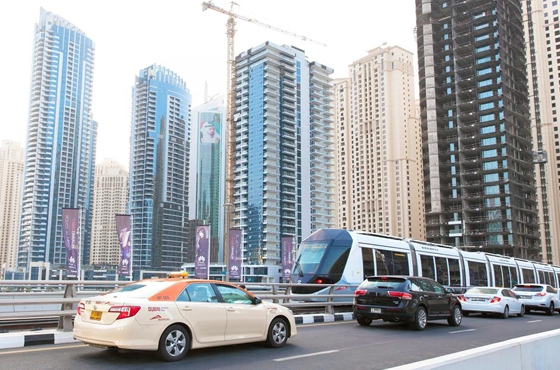With 2017 oil prices faring relatively better than last year, the Gulf Cooperation Council (GCC) countries are taking a multi-faceted and calibrated approach at initiating infrastructure projects bearing the potential to diversify their economy and revenue streams. The rationale includes avoiding excessive exploitation of fossil fuel resources and prolonging the foreign exchange component of its exports.
As part of Saudi Arabia’s Vision 2030 strategy, the government has outlined infrastructure projects spanning the power, water, hydrocarbons, construction, road, rail, seaport and airport sectors. Riyadh’s aim is to improve private sector contribution to the GDP from 40 per cent to 65 per cent and increase revenues from non-oil sectors from $43 billion to $267 billion by 2030.
Sticking to this plan, Riyadh overlooked its strict social code and announced plans in April 2017 to build the kingdom’s largest entertainment, cultural and sports city near the capital. The project is scheduled to begin in 2018, with the first phase expected to open in 2022.
Taking a comprehensive view of Saudi Arabia’s $1trillion project market, a 2016 Middle East Economic Digest report analyzed that the construction sector gets the biggest share of projects worth $442 billion, followed by $228 billion and $170 billion for the transport and power sectors respectively.
In the power sector, Saudi Arabia is expected to launch a renewable energy program between 2017 and 2023 to produce 10 gigawatts of power. This involves an investment of between $30 and $50 billion. In addition, Riyadh has initiated feasibility studies for two commercial nuclear reactors.
Most of the projects are likely to be public-private partnerships (PPP), thus offering new openings to investors. Further, Saudi Arabia is exploring ways to link its renewable energy projects with Yemen, Jordan and Egypt, thus increasing the overall stakes.
After an initial freeze on projects in 2016 due to cash crunch, Saudi authorities announced three public transport projects in Jeddah this January. Buoyed by relatively higher oil prices and adopting the PPP model, the projects include a tram line and a marine taxi service. Accordingly, infrastructure and transport spending is expected to increase by 39 per cent this year over 2016.
An early 2017 study by Faithful & Gould consultancy suggested that the Saudi government would award projects worth $27 billion in 2017 as opposed to $35.5 billion and $20 billion during 2015 and 2016 respectively.
Amid the optimistic scenario, the study also sounded a note of caution – state-driven projects worth about $13.3 billion could be cancelled due to changing priorities.
Linking a country’s infrastructure to its business potential and performance, international consultancy firm Arcadis rated China and the United States at the top in terms of optimizing their built assets. Saudi Arabia and the UAE were placed 22nd and 24th respectively. While China’s gains during the 2014-16 period was estimated at 12 per cent, valued at $10.4 trillion, up from $9.3 trillion in 2014, Saudi Arabia saw a 47 per cent jump to $364 billion and the UAE registered a 16 per cent increase to $351 billion.
Moving on with diversification in the UAE, Abu Dhabi is spending $37 billion on various projects up to 2020, including completion of the Louvre museum, a new airport terminal and the nuclear power plants in Barakah.
In Dubai, which is gearing up for Expo 2020, the government announced that it would award 47 construction contracts worth $3 billion in 2017. The contracts which are open to both local and international firms constitute the third and final infrastructure package for the expo’s support areas.
Other key contracts for this year include the construction of the three Thematic Districts that will host majority of the expo pavilions. It also pertains to the public areas and the development of all temporary infrastructure required to host the first such event in the Middle East.
The outlay was part of the emirate’s expansionary budget, which increased by 2.6 per cent overall, but boosted the infrastructure allocation by 27 per cent – up from 20 per cent in 2016.
These latest announcements in the UAE came as a shot in the arm for businesses anxious about the country’s economic growth prospects and the government’s spending plans to boost the same.
According to Abu Dhabi Commercial Bank forecasts, the UAE’s non-oil growth is tipped to be 2.9 per cent in 2017, up from 2.3 per cent last year. Emirates NBD predicted that the UAE’s economy would register a 3.4 per cent growth this year, compared to 3 per cent in 2016.
Elsewhere, Qatar – which is hosting the 2022 World Cup – is expected to invest about $13 billion in construction and transport infrastructure projects in 2017. This is in addition to the $100 billion already spent on the impending mega soccer event.
The government revealed that about $500 million is being spent every week on the infrastructure projects associated with the FIFA event. With 90 per cent of the contracts already awarded, Doha expects two-thirds of the World Cup projects to be completed by late 2018. Overall, more than $200 billion has been assigned for the tournament-related projects.
Countering concerns about the utility of these projects after the World Cup, especially in light of the wasteful events after the last World Cup in Brazil, the government has said that developments are linked among transport, tourism, education and real estate sectors. This would hold the country’s investment in good stead and contribute positively to the Qatar National Vision 2030.
The same outlook could hold true for the other GCC countries as well.
AMEinfo
12 April























































